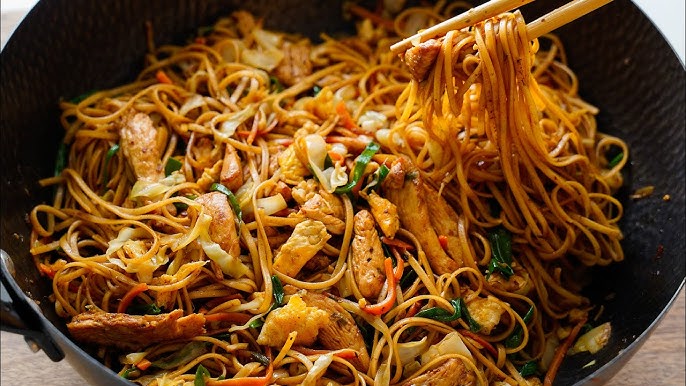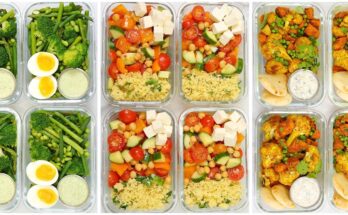Chow Mein Recipe: Chow Mein, a delightful stir-fried noodle dish, is a favorite in Chinese cuisine and beyond. Its irresistible combination of chewy noodles, fresh vegetables, and flavorful sauces has made it a beloved comfort food worldwide. Whether you’re a novice cook or a seasoned chef, mastering Chow Mein at home is easier than you think.
Plus, homemade Chow Mein is tastier, healthier, and allows you to customize the ingredients to suit your taste.
Ingredients for Chow Mein
To create the perfect Chow Mein, you’ll need the following:
Essential Ingredients:
- Chow Mein noodles (or egg noodles)
- Vegetable oil
- Garlic (minced)
- Ginger (minced)
- Soy sauce
- Oyster sauce
- Sesame oil
- Protein of choice (chicken, shrimp, beef, or tofu)
- Mixed vegetables (carrots, bell peppers, cabbage, and bean sprouts)
Optional Ingredients for Customization:
- Chili paste for heat
- Green onions for garnish
- Cashews or sesame seeds for crunch
Recommended Substitutes:
- Tamari for soy sauce (gluten-free option)
- Hoisin sauce for a sweeter flavor
- Zucchini noodles for a low-carb version
Having these ingredients on hand ensures your Chow Mein is packed with authentic flavor and texture.
Tools and Equipment Needed
Cooking Chow Mein doesn’t require fancy tools, but having the right ones can elevate the process:
Cooking Tools:
- Wok or large skillet (preferably non-stick)
- Wooden spatula for stir-frying
- Large pot for boiling noodles
Prepping Utensils:
- Sharp knife for slicing vegetables
- Cutting board
- Mixing bowls for sauces
The wok is the star tool in this recipe, providing high heat for quick, even cooking.
Preparing Ingredients for Chow Mein
Preparation is key to smooth cooking. Follow these steps:
1. Cutting Vegetables: Slice vegetables like carrots, bell peppers, and cabbage into thin, uniform strips to ensure even cooking. Julienne cuts work best for Chow Mein.
2. Prepping Proteins: Marinate your chosen protein (chicken, shrimp, or tofu) in a mixture of soy sauce, garlic, and ginger for at least 15 minutes to enhance flavor.
3. Cooking Noodles: Boil Chow Mein noodles according to package instructions, usually 2–3 minutes. Drain and toss with a little oil to prevent sticking.
Step-by-Step Cooking Instructions
Step 1: Heat Oil and Sauté Aromatics
Heat two tablespoons of oil in your wok over high heat. Add minced garlic and ginger, stirring quickly to release their aroma. Be careful not to burn them!
Step 2: Cook the Protein
Add marinated protein to the wok. Stir-fry until fully cooked, about 3–5 minutes. Remove and set aside.
Step 3: Add Vegetables and Stir-Fry
In the same wok, toss in the prepared vegetables. Stir-fry on high heat for 2–3 minutes until they’re slightly tender but still crisp.
Step 4: Toss in Noodles and Sauce
Add cooked noodles to the wok. Pour in soy sauce, oyster sauce, and sesame oil. Toss everything together, ensuring the sauce coats the noodles evenly.
Step 5: Perfecting the Final Toss
Reintroduce the protein and mix well. Stir-fry for an additional minute, allowing flavors to meld perfectly.
Tips for Perfect Chow Mein
- Achieve Smoky Flavor: Use a high flame and don’t overcrowd the wok. This helps to achieve a smoky, “wok hei” flavor.
- Balance Sauces: Start with less sauce and adjust to taste after mixing.
- Avoid Overcooking: Keep vegetables crunchy and noodles al dente for the best texture.
Variations of Chow Mein
Chow Mein is wonderfully versatile, allowing you to create variations based on dietary preferences or available ingredients. Here are a few popular options:
Vegetable Chow Mein: Skip the meat and load up on fresh vegetables like broccoli, snap peas, and mushrooms. This version is perfect for vegetarians or anyone seeking a lighter meal.
Chicken Chow Mein: A classic favorite, this version features tender chicken strips stir-fried to perfection. It’s a protein-packed option that pairs well with any veggies.
Shrimp or Seafood Chow Mein: Enhance your Chow Mein with shrimp, scallops, or even crabmeat. The natural sweetness of seafood complements the savory noodles beautifully.
Each variation can be customized further with your favorite seasonings or garnishes, making it easy to create a dish that suits your cravings.
Serving Suggestions
Chow Mein is delightful on its own, but pairing it with complementary sides can elevate the meal:
- Dumplings or Spring Rolls: Crispy appetizers that balance the softness of the noodles.
- Hot and Sour Soup: A tangy, spicy soup that enhances the Chow Mein experience.
- Steamed Rice: Serve as a side for larger portions or shared meals.
For a finishing touch, garnish your Chow Mein with chopped green onions, sesame seeds, or a drizzle of chili oil.
Storing and Reheating Leftovers
Storing Chow Mein:
Place leftovers in an airtight container and store in the refrigerator for up to 3 days. Avoid leaving Chow Mein at room temperature for extended periods to prevent spoilage.
Reheating Tips:
- Microwave: Heat in 30-second intervals, stirring occasionally. Add a splash of water or soy sauce to prevent dryness.
- Stovetop: Warm in a skillet with a small amount of oil over medium heat. This method helps retain the original texture.
Proper storage and reheating ensure your Chow Mein remains just as delicious the next day.
Health Benefits of Homemade Chow Mein
Homemade Chow Mein is not only delicious but can also be a nutritious choice:
- Rich in Vegetables: Packed with vitamins and fiber, the vegetables add essential nutrients.
- Customizable for Health: Control the amount of oil and sodium by adjusting sauces.
- High in Protein: Adding chicken, shrimp, or tofu makes it a balanced meal.
For a healthier version, use whole-grain noodles and increase the ratio of vegetables to noodles.
Regional Variations of Chow Mein
Chow Mein’s versatility has led to unique versions across the globe:
Chinese-Style Chow Mein: This traditional version uses authentic Chinese ingredients like soy sauce, sesame oil, and bok choy, retaining the dish’s classic simplicity.
American-Style Chow Mein: Often served with crispy noodles and a thicker sauce, this variation is adapted for Western palates.
Indian-Style Chow Mein: Infused with spices like garam masala and green chilies, this spicy version is a street food favorite in India.
Each style brings a distinct flavor profile, showcasing Chow Mein’s adaptability across cultures.
Troubleshooting Common Issues
1. Noodles Sticking Together: Toss cooked noodles with a bit of oil before stir-frying to prevent clumping.
2. Overcooked or Soggy Vegetables: Stir-fry vegetables on high heat for a shorter time to keep them crisp and vibrant.
3. Adjusting Flavors After Cooking: If the dish feels bland, add soy sauce or sesame oil in small amounts. If too salty, balance with a pinch of sugar or extra veggies.
FAQs about Chow Mein Recipe
1. What are the essential ingredients for Chow Mein?
Chow Mein typically requires noodles, soy sauce, vegetables like cabbage and carrots, and a protein such as chicken, beef, or shrimp. Sesame oil and oyster sauce are also popular for added flavor.
2. What type of noodles should I use for Chow Mein?
Traditional Chow Mein is best made with fresh egg noodles. However, you can use dried egg noodles or even spaghetti in a pinch. Make sure to cook them just until al dente.
3. Can Chow Mein be made vegetarian?
Absolutely! For a vegetarian version, omit the meat and add more vegetables like bell peppers, peas, and mushrooms. Tofu is a great protein substitute in vegetarian Chow Mein.
4. How do I ensure my Chow Mein isn’t soggy?
To avoid soggy Chow Mein, make sure to cook your noodles until just underdone since they will continue cooking when stir-fried. Also, stir-fry your vegetables and proteins quickly on high heat to retain their crunch and moisture.
5. What’s the difference between Chow Mein and Lo Mein?
The main difference lies in how the noodles are prepared. Chow Mein noodles are stir-fried to a crisp texture, while Lo Mein noodles are boiled and then mixed with ingredients resulting in a softer dish.
6. How can I add more flavor to my Chow Mein?
Increase the depth of flavor by adding garlic, ginger, a splash of rice vinegar, or a teaspoon of chili paste for heat. Experimenting with the balance of soy sauce and oyster sauce can also enhance the flavor.
Conclusion
Making Chow Mein at home is a rewarding experience that combines creativity, flavor, and simplicity. With this step-by-step guide, you can recreate your favorite takeout dish with ease, ensuring a healthier, tastier meal tailored to your preferences. So why wait? Grab your wok, gather your ingredients, and whip up a delicious Chow Mein today!



